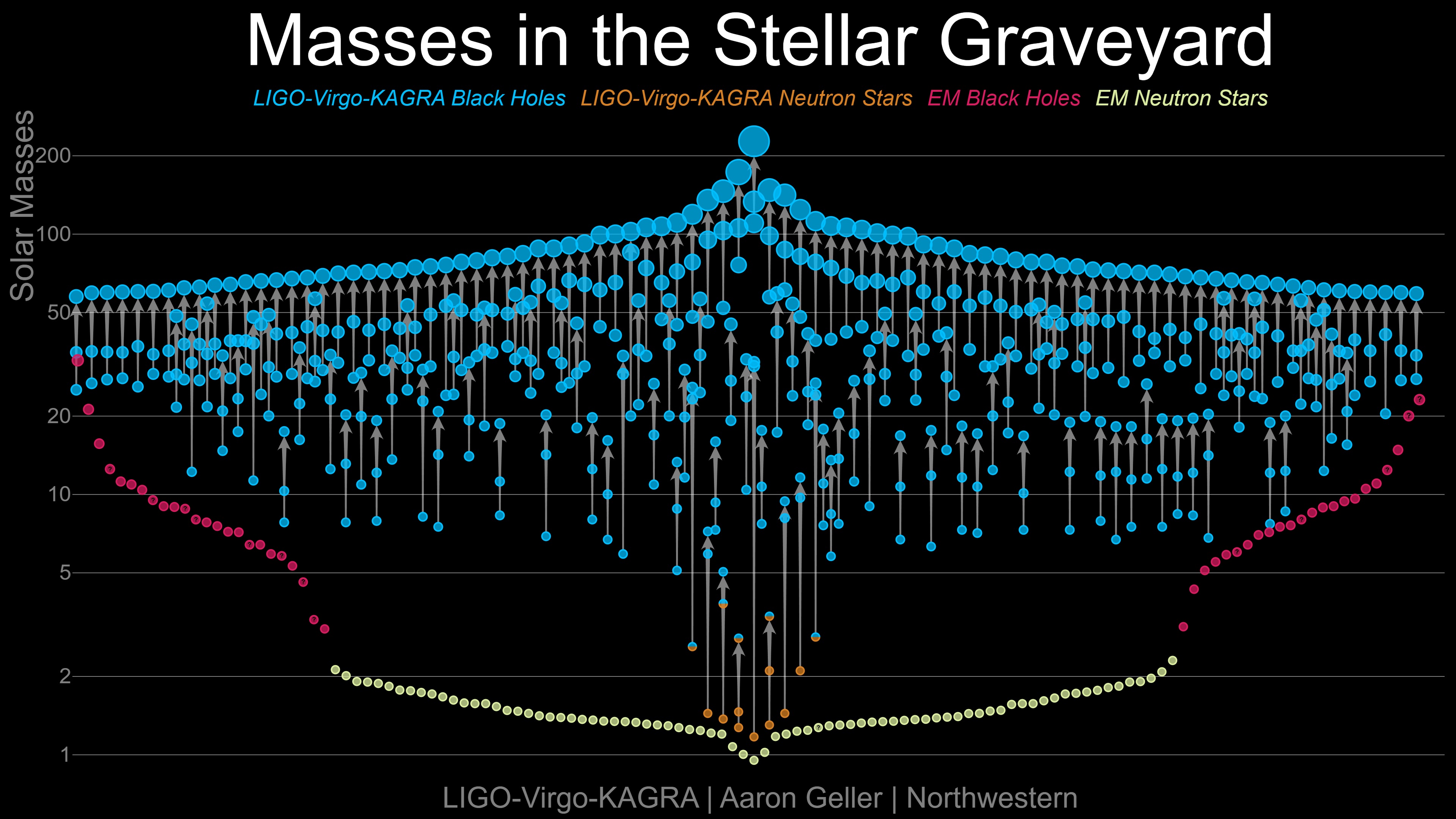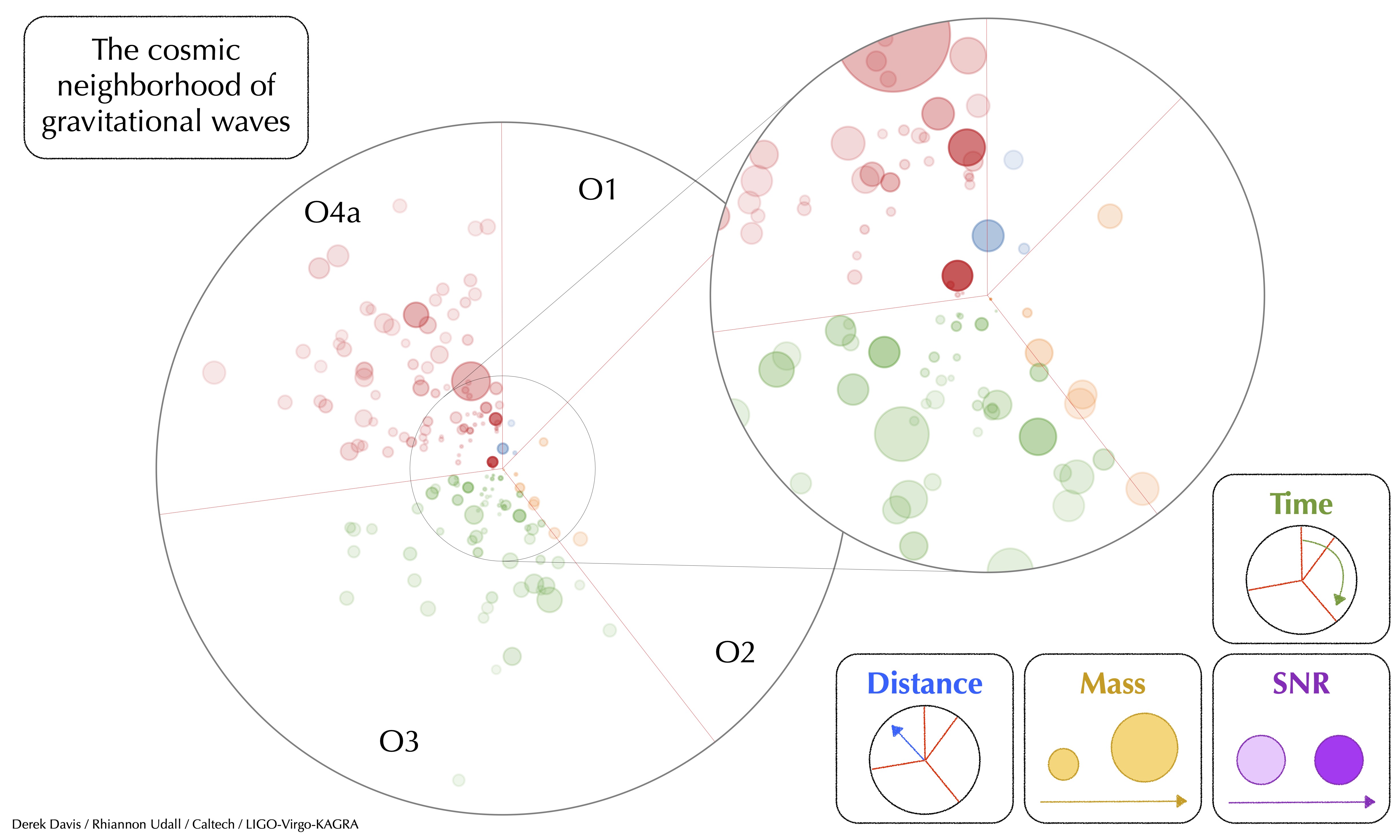International collaboration doubles number of black hole collisions detected
Published: 26 August 2025
Researchers from the University of Glasgow led an international team of scientists who analysed the data which is released today from the fourth observing run of the LIGO, Virgo, and KAGRA gravitational-wave observatories
When the remnants of some of the Universe’s largest stars collide they create ripples which travel through the geometry of space and time which are detected by the LIGO, Virgo, and KAGRA gravitational-wave observatories.
First detected in 2015, measuring these ripples - gravitational-waves - require the most sensitive instruments ever created. While created by some of the Universe’s most violent events, by the time they reach Earth, gravitational waves are almost imperceptibly small. Decades of research were needed to develop the detectors to make the first observation.
Researchers from the University of Glasgow led an international team of scientists who analysed the data which is released today from the fourth observing run of these detectors, with data collected between May 2023 and January 2024.
This new analysis, which is presented in ‘GWTC-4.0: Updating the Gravitational-Wave Transient Catalog with Observations from the First Part of the Fourth LIGO-Virgo-KAGRA Observing Run’ as a preprint available from the arXiv, more than doubles the number of collisions between black holes and neutron stars reported to date, with 128 new mergers detected in the nine months of data analysed.

“This new update really highlights the capabilities of both the international network of gravitational-wave detectors, and the analysis techniques which have been developed to dig very faint signals out of the data,” said paper co-author Dr Daniel Williams, a research fellow in the Institute for Gravitational Research (IGR) at the University of Glasgow, who led the team who performed the analysis.
“What we’ve observed in the first part of the two-year-long fourth observing run has broadened our understanding of the cosmic graveyard: we’ve seen the heaviest black holes yet.”
The catalogue also contains signals from two mergers between black holes and neutron stars; one of these was previously published as GW230529, but a second, GW230518, is fully described here for the first time. Collisions of this kind may produce bright bursts of light as the neutron star is consumed by the black hole.
“This time around we didn’t see anything except for gravitational waves from these mergers, but exciting new telescopes such as the Vera Rubin Telescope mean that making coincident detections of gravitational waves and light is becoming much more likely,” added Dr Williams.
Understanding the diversity of neutron star black hole binaries will help astronomers target their observations to maximise the chance of catching the rare flash of light accompanying a merger.
The large number of new detections are thanks to sensitivity improvements which have been made to the LIGO detectors since 2020. The University of Glasgow has made key contributions to the development of these detectors over the last three decades.
“During the fourth observing run the detectors have routinely been able to make measurements more than 25% more sensitive than in the previous observing run. This allows us to observe a much larger fraction of the Universe,” said Dr Andrew Spencer, a lecturer in the IGR.

The enhanced sensitivity of the detectors means we can detect more sources, and it also means that we can make clearer measurements of gravitational-wave signals.
The observation GW230814 is the loudest gravitational-wave observation to date.
“Gravitational-wave signals are the perfect way to test Einstein’s theory of gravity. The louder the signal, the more precise our measurements of any potential deviations,” explained the IGR’s Dr John Veitch. “So far Einstein has passed every test, but we will keep looking closer! For these types of analysis, it is very important to have observations from multiple gravitational-wave detectors, so you can cross-reference the signal in both.”
As we gather more detections we can also learn more about the fundamental nature of the Universe.
“The Universe is expanding, and the speed at which it is doing so is known as the Hubble Constant. A unique feature of black hole mergers is that we can tell how far away they were directly from our observation”, said Dr Rachel Gray, a lecturer in the IGR who leads the Collaboration’s cosmological science group.
“This means that each merger we detect gives some information about the Universe's expansion rate. By combining this information from many mergers, we can improve our measurement of the Hubble Constant, helping to answer one of the big unanswered questions of modern astronomy: exactly how fast is the Universe expanding?”
The new variety of different mergers also casts new light on how stars have evolved over the history of the Universe.
“In a similar way to how a palaeontologist can learn about long-extinct dinosaurs by looking at their fossilised bones, we can learn about stars by looking at their black hole or neutron star remains,” said Dr Christopher Berry of the IGR.
“The biggest stars live the shortest lives, so they can be hard to study in other ways. Stars live their lives in many different environments. Some form in dense stellar environments like nuclear star clusters, where millions of stars are in close proximity. Here, we might expect that following a binary black hole merger, the remnant black hole could find a new partner and merge again, forming an even bigger black hole.
“In GWTC-4.0 we’ve seen tell-tale hints that some of the sources could come from black holes that were themselves the result of previous mergers. Teasing out the black holes formed from collapsing stars from those formed from previous mergers will tell us about how stars live their lives, and where they live their lives across the Universe.”
First published: 26 August 2025
<< August

